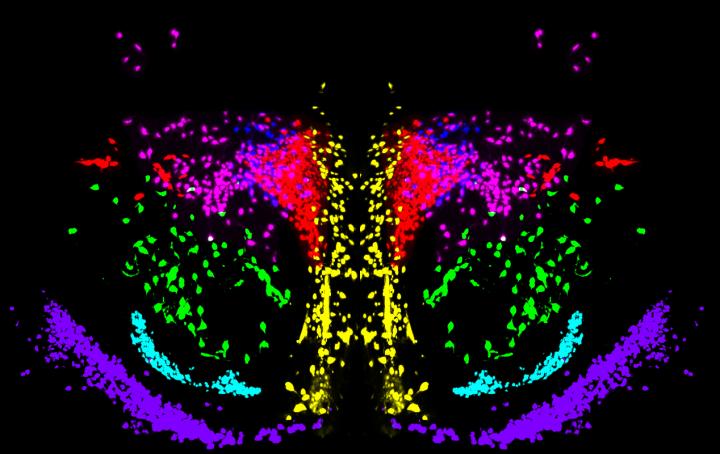Alterations in these circuits may underlie mental disorders characterized by deficits in social interaction, such as autism, social anxiety and aggression, or schizophrenia.

Credit: IN-CSIC-UMH
The work, carried out by Pilar Madrigal and Sandra Jurado, from the UMH-CSIC Neurosciences Institute in Alicante, a joint center of the Spanish National Research Council and Miguel Hernández University, has been published in Communications Biology, a Nature group´s journal.
“Our in-depth analysis of the oxytocin-vasopressin circuit in the mouse brain has revealed that these two molecules have distinct dynamics throughout embryonic development. It is likely that these adaptations modulate the functional properties of different brain regions according to their developmental stage, contributing to the refinement of the neural circuits that are at the basis of social behaviors,” explains Dr. Sandra Jurado, director of the Synaptic Neuromodulation Laboratory and the Cell and Systems Neurobiology Unit of the Institute of Neurosciences.
Very similar in structure, oxytocin and vasopressin are two neuropeptides that are evolutionary conserved and are involved in the regulation of complex social behaviors such as maternal care and pair bonding.
Although it is not known how oxytocin and vasopressin modulate brain function, numerous studies in animals and humans suggest that alterations in these circuits may underlie mental disorders characterized by deficits in social interaction, such as autism, anxiety and social aggression or schizophrenia. “For us, it has been very important to identify how these circuits are formed during brain development, in order to detect potential alterations that could be related to social disorders,” says Dr. Jurado, who has led the research.
To date, most of the studies to characterize the expression of oxytocin and vasopressin projections have used histological methods and in situ hybridization in brain sections that provide relevant information, but which are difficult to extrapolate to the formation of three-dimensional circuits in the brain.
In addition, most previous work has focused on the rat brain, although an increasing number of studies employ the mouse as an experimental model, highlighting the need for more accurate connectivity maps for this commonly-used species in the laboratory.
MODULATION OF SOCIAL BEHAVIOR
Produced in the hypothalamus, the brain region responsible for controlling essential behaviors for survival, oxytocin acts both as a hormone and as a neurotransmitter. This small, primitive molecule plays an important role in both basic functions such as osmotic balance in invertebrate species and complex behaviors like reproduction and maternal behaviors in humans.
Although oxytocin is best known for increasing muscle contraction during childbirth, it also plays an important role in reproductive and social behaviors. Thanks to this hormone, our brain is able to maintain affective relationships with our peers. And one of the most primitive and strongest in mammals is precisely the close relationship between a mother and her children. Oxytocin is popularly known as the “love hormone”, as it promotes social contact, partner preferences and subsequent attachment. It also produces a sense of security and well-being and reduces stress.
Similarly, vasopressin promotes social contact, mate preference and attachment, modulates territorial behaviors towards potential same-sex rivals, increases attraction, as well as sexual and reproductive behaviors.
THE TRANSPARENT BRAIN
In this study, Madrigal and Jurado have implemented the iDISCO+ clarification technique, which allows the removal of a large part of the lipid (fat) content of the brain without damaging its structure, to make it transparent. This method, in combination with light sheet fluorescence microscopy, has allowed the researchers to generate 3D reconstructions with high cellular resolution of the oxytocinergic and vasopressinergic systems of the entire mouse brain, from early development to adulthood.
Thanks to this methodology they have been able to make a precise classification of the cells that synthesize oxytocin and vasopressin in deep brain nuclei, such as the hypothalamus. Interestingly, the Spanish researchers have observed that the various hypothalamic nuclei show marked differences in the expression of oxytocin and vasopressin during embryonic development.
In addition, they have seen a high presence of mixed (oxytocin and vasopressin) cells during early developmental stages, which declines in most hypothalamic nuclei as growth progresses. “It is likely that these dynamic adaptations allow modulation of oxytocin and vasopressin levels in different brain regions according to developmental stage. This change would make possible the refinement of neural circuits that underlie social behaviors,” the researchers said.
These adaptations show differences between the mouse and rat brain, making this study a new benchmark for researchers studying social behavior based on murine models, whose neurodevelopment shares many characteristics with the human brain.
###
Madrigal, M.P., Jurado, S. Specification of oxytocinergic and vasopressinergic circuits in the developing mouse brain. Commun Biol 4, 586 (2021). https:/
Media Contact
Pilar Quijada
[email protected]
Original Source
https:/
Related Journal Article
http://dx.




